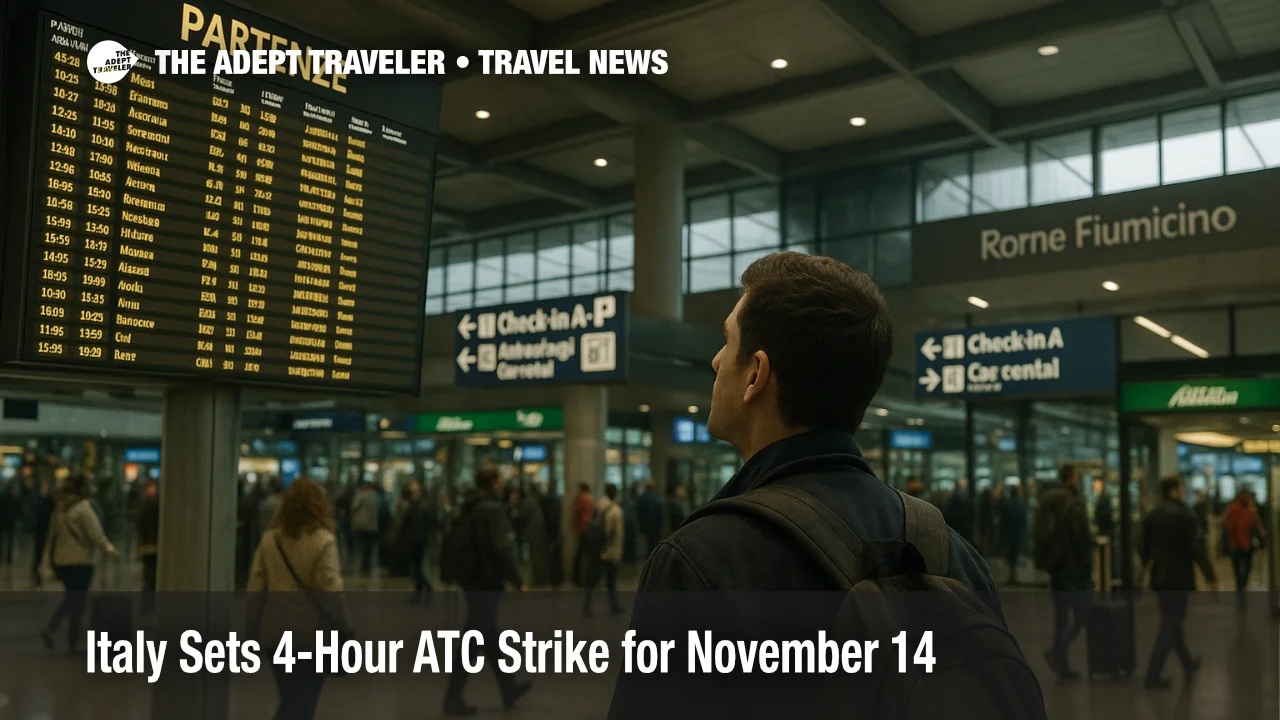Italy Sets 4-Hour ATC Strike for November 14

Key points
- Italy's ENAV air traffic control staff will strike nationwide on November 14 from 1:00 to 5:00 p.m. CET under an ASTRA action
- Italy's three FIRs and four ACCs are in scope, so delays and selected cancellations can ripple across domestic and short-haul Europe
- Protected time bands in Italy mean flights 7:00-10:00 a.m. and 6:00-9:00 p.m. local are generally guaranteed
- EasyJet Italy crews plan a parallel 1:00-5:00 p.m. action and Volotea staff a 24-hour strike the same day
- Travelers should move critical segments outside the 1:00-5:00 p.m. window and monitor airline advisories and waivers
Impact
- When
- Friday, November 14, 1:00-5:00 p.m. CET
- Where
- Nationwide in Italy, with knock-ons to nearby European flows
- Who Is Affected
- Domestic Italy, intra-Europe connections, and some overflights transiting Italian airspace
- Protected Bands
- Flights 7:00-10:00 a.m. and 6:00-9:00 p.m. local generally operate
- What To Do
- Shift to earlier or later departures, avoid tight connections, watch airline waivers and airport feeds
- Most Exposed Airports
- Rome Fiumicino, Milan Malpensa and Linate, Venice, Naples, Palermo, Catania
Italy's air traffic control, ATC, staff at ENAV are scheduled to stop work nationwide for four hours on Friday, November 14, from 1:00 p.m. to 5:00 p.m. CET, under an action called by the ASTRA union. Italy's transport ministry strike calendar lists the ENAV action as a national four-hour walkout in the air transport sector, signaling likely delays and targeted cancellations even with minimum service rules in place.
What changed and why it matters
The timing consolidates multiple sector actions into one risk window. In addition to ENAV's controllers, Italy's strike roster shows a simultaneous four-hour easyJet Italy cabin-crew action and a separate 24-hour Volotea staff strike on November 14, which can compound disruption for specific carriers. Travelers with domestic or short-haul European segments should move critical flights outside 100-500 p.m. local or build generous buffers.
Italian airspace: FIRs and ACCs in scope
Operationally, the strike can touch all three Italian Flight Information Regions, FIRs, Milano (LIMM), Roma (LIRR), and Brindisi (LIBB), which comprise Italy's lower airspace; ENAV also runs four Area Control Centres, ACCs, at Rome, Milan, Padua, and Brindisi that sequence en-route traffic. When controllers at towers and ACCs reduce staffing, en-route capacity and approach flows are throttled, propagating delays beyond the immediate window.
Protected time bands
Italy maintains "fasce di garanzia," protected bands in which flights are generally ensured even during strikes. For air transport these typically include morning and evening windows, such as 700-1000 a.m. and 600-900 p.m. local, which can help early departures and later bank flights run. Expect queues and residual delays on either side of the 100-500 p.m. action as flows rebuild.
Latest developments
The national strike was formally posted on the Ministry of Infrastructure and Transport's strike portal, showing ENAV personnel, four hours, 100-500 p.m., nationwide, under ASTRA. Related entries list easyJet Italy cabin crew for a matching 100-500 p.m. action and a 24-hour Volotea staff strike on the same date.
Airport-by-airport mitigation tips
Rome Fiumicino (FCO) Priority long-haul often operates with delays, but intra-EU banks around 100-500 p.m. CET can see targeted cancellations. Move connections into the 700-1000 a.m. or 600-900 p.m. bands where possible and use earlier Leonardo Express rail into Termini to avoid tight gate arrivals.
Milan Malpensa (MXP) and Milan Linate (LIN) Milan flows are sensitive to ENAV ACC Milan rates. If you must connect across airports, avoid cross-town transfers during the strike window and prefer nonstop options. For MXP, consider the Malpensa Express rail to keep buffer time predictable.
Venice (VCE), Naples (NAP), Catania (CTA) These hubs can suffer rotations if upstream flows from Rome or Milan slow. Book earlier departures, carry-on only if feasible, and monitor gate changes.
Palermo (PMO) In addition to the ENAV action, Palermo's airport company staff have a separate 24-hour strike posted for November 14. Expect added terminal-side friction and plan longer check-in and security buffers if you must travel that day.
Typical airline protections for short strikes
For four-hour industrial actions, many carriers offer no-fee changes into protected bands or the following day on the same routing or nearby airports. Low-cost carriers may allow free same-day moves within the window's edges, while network carriers commonly expand to a one- or two-day rebooking horizon for disrupted connections. Watch for airline-specific advisories if your flight touches Italy during the 100-500 p.m. CET window.
Background: How Italian ATC is structured
ENAV provides tower and approach control at 45 airports and manages en-route traffic via the four ACCs at Rome, Milan, Padua, and Brindisi. The nationwide nature of the November 14 action means any of the three FIRs can see flow restrictions, especially where sectors feed Rome and Milan arrivals. Even if your airport is not striking locally, overflight and sequencing constraints can still delay your flight.
Final thoughts
Italy's November 14 ATC strike is brief, but it sits in the middle of the day and intersects with other labor actions. If your itinerary touches Italy, move departures outside 100-500 p.m. CET, protect connections into the evening guaranteed band, and refresh your airline's alert settings. That approach minimizes exposure while the system absorbs the four-hour shock.
